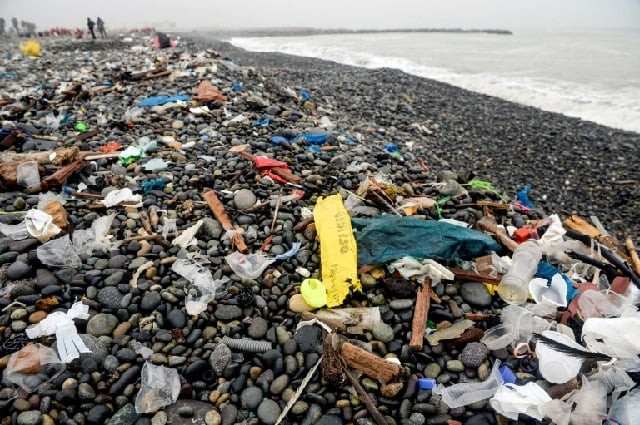Plastics have entered human food chain, study shows
Global plastic production has grown rapidly and is currently more than 400 million tonnes per year

Global plastic production has grown to more than 400 million tonnes a year, and an estimated two to five per cent of it winds up in the ocean. PHOTO AFP
All eight volunteers in a small pilot study were found to have passed several types of plastic, with an average of 20 micro-particles per 10g of stool, researchers reported Tuesday at a gastroenterology congress in Vienna.
The scientists speculated that the tiny specks - ranging in size from 50 to 500 micrometres - may been ingested via seafood, food wrapping, dust or plastic bottles.
A human hair is roughly 50 to 100 micrometres in width.
"In our laboratory, we were able to detect nine different types of plastics," said Bettina Liebmann, a researcher at the Federal Environment Agency, which analysed the samples.
The two most common were polypropylene - found in bottle caps, rope and strapping - and polyethylene, present in drinking bottles and textile fibres.
Together with polystyrene (utensils, cups, coolers) and polyethylene (plastic bags), they accounted for more than 95 per cent of the particles detected.
Plastic pollution in Pakistan
"We were unable to establish a reliable connection between nutritional behaviour and exposure to microplastics," said lead author Philipp Schwabl, a researcher at the Medical University of Vienna.
In earlier studies on animals, the highest concentrations of microplastics were found in the stomach and intestines, but smaller amounts have also been detected in blood, lymph and the liver.
"There are initial indications that microplastics can damage the gastrointestinal tract by promoting inflammatory reactions or absorbing harmful substances," Schwabl said.
"Further studies are needed to assess the potential dangers of microplastics for humans."
Schwabl recruited five women and three men, aged 33 to 65, in Finland, the Netherlands, Britain, Italy, Poland, Russia, Japan and Austria.
Each kept a week-long log of what they ate, and then provided a stool sample.
All consumed foods wrapped in plastic and beverages in plastic bottles, and six ate seafood. None were vegetarians.
Scientists not involved in the study said it was too limited in scope to draw any firm conclusions, especially about health impacts.
"I'm not at all surprised, or particularly worried by these findings," commented Alistair Boxall, a professor in environmental science at the University of York in Britain.
Hazards of plastic pollution
"Microplastics have been found in tap water, bottled water, fish and mussel tissue, and even in beer," he added. "It is therefore inevitable that at least some of these things will get into our lungs and digestive system."
Much more research is needed, he said, before we can determine the origin of plastics found in the gut, and especially whether they are harmful.
For Stephanie Wright, a researcher at King's College London, the real question is whether plastics are accumulating in the human body.
"What is unknown is whether the concentration of plastic being ingested is higher than that coming out, due to particles crossing the gut wall," she said.
"There is no published evidence to indicate what the health effects might be."
Global plastic production has grown rapidly, and is currently more than 400 million tonnes per year.
It is estimated that two to five per cent of plastics wind up in the ocean, where much of it breaks down into tiny particles.



















COMMENTS
Comments are moderated and generally will be posted if they are on-topic and not abusive.
For more information, please see our Comments FAQ